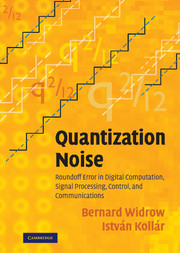 Quantization Noise
Quantization Noise Book contents
- Frontmatter
- Contents
- Preface
- Acknowledgments
- Glossary of Symbols
- Acronyms and Abbreviations
- Part I Background
- Part II Uniform Quantization
- Part III Floating–Point Quantization
- Part IV Quantization in Signal Processing, Feedback Control, and Computations
- Part V Applications of Quantization Noise Theory
- 19 Dither
- 20 Spectrum of Quantization Noise and Conditions of Whiteness
- Part VI Quantization of System Parameters
- APPENDICES
- Bibliography
- Index
20 - Spectrum of Quantization Noise and Conditions of Whiteness
from Part V - Applications of Quantization Noise Theory
Published online by Cambridge University Press: 06 July 2010
- Frontmatter
- Contents
- Preface
- Acknowledgments
- Glossary of Symbols
- Acronyms and Abbreviations
- Part I Background
- Part II Uniform Quantization
- Part III Floating–Point Quantization
- Part IV Quantization in Signal Processing, Feedback Control, and Computations
- Part V Applications of Quantization Noise Theory
- 19 Dither
- 20 Spectrum of Quantization Noise and Conditions of Whiteness
- Part VI Quantization of System Parameters
- APPENDICES
- Bibliography
- Index
Summary
When the input to a quantizer is a sampled time series represented by x1, x2, x3, …, the quantization noise is a time series represented by ν1, ν2, ν3, … Suppose that the input time series is stationary and that its statistics satisfy the conditions for multivariable QT II (it would be sufficient that two–variable QT II conditions were satisfied for x1 and x2, x1 and x3, x1 and x4, and so forth, because of stationarity). As such, the quantization noise will be uncorrelated with the quantizer input, and the quantization noise will be white, i.e. uncorrelated over time. The PQN model applies. The autocorrelation function of the quantizer output will be equal to the autocorrelation function of the input plus the autocorrelation function of the quantization noise.
Fig. 20.1(a) is a sketch of an autocorrelation function of a quantizer input signal. Fig. 20.1(b) shows the autocorrelation function of the quantization noise when the PQN model applies. Fig. 20.1(c) shows the corresponding autocorrelation function of the quantizer output.
Corresponding to the autocorrelation functions of Fig. 20.1, the power spectrum of the quantizer output is equal to the power spectrum of the input plus the power spectrum of the quantization noise. This spectrum is flat, with a total power of q2/12.
- Type
- Chapter
- Information
- Quantization NoiseRoundoff Error in Digital Computation, Signal Processing, Control, and Communications, pp. 529 - 562Publisher: Cambridge University PressPrint publication year: 2008
- 1
- Cited by
